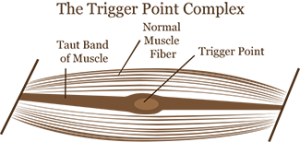FACTS ABOUT MYOFASCIALTRIGGER POINTS |
|
DISCOVERY & HISTORY… |
 |
|
WHAT THEY ARE… |
A Trigger Point = a very small area of SPASM within your muscle. |
|
|
|
The trigger point can be latent (not in spasm, but with potential – like a dormant volcano) or active (spasmed and painful.)
Some people have a few active trigger points, some people have dozens.
|
|
WHAT THEY DO…
|
Active trigger points cause muscle pain. Latent trigger point can cause stiffness in a muscle.
Triggers are created by a protective mechanism in your body – a message that tells a muscle to tighten up to prevent further damage.
As a protective reflex, this is fine, however the problems occur when the muscle does not relax. |
|||

Trigger Points act like the trigger of a gun – |
||||
|
The pain distribution patterns of trigger points can be complex and unexpected.
eg. a trigger point in your shoulder can cause pain up your neck, into your head – like a classic tension headache.
Once you know these patterns, you can find the trigger points responsible for your pain. |
|
|
PRIMARY & SATELLITE TRIGGERS… |
 |
If you have pain – say a sore shoulder – there will be one main trigger point – that’s the primary trigger point.
Often there will also be a group of active secondary trigger points – the satellite trigger points.
Treating the primary trigger point will reduce the pain, but it’s important to switch off all the satellite triggers for full pain relief. |
|
DIFFERENTIAL DIAGNOSIS |
|
Trigger point pain is similar to a very long list of common problems. However, they are often ignored as a possible source of pain.
In addition, trigger points get switched on by pain – so they could also exist as a secondary problem to a prolapsed disc (for instance.)
Here are some problems trigger point pain can mimic: |
||
CAUSES OF TRIGGERS |
|
|
Trigger points are caused by a protective mechanism designed to keep your body safe. So anything that stresses your muscles can produce trigger points. |
||
|
|
|
|
TREATMENT OF TRIGGERS |
TOOLS |
You can use tools to treat trigger points that you can’t easily reach in this way. ie. trigger points in your back. |
||
|
|
|
||
|
#2
|
Hot & Cold This time, the message is interrupted by applying cold and then heat to the area.
|
|
|
#3
|
Myofascial Release This time, the message is interrupted by applying cold and then heat to the area.
|
|
|
|
Dry Needling
To dry needle a trigger point, typically acupuncture needles are used. The practitioner searches for the trigger point with their hands.
Once the trigger point is found, the needle is inserted. The therapist is trying to get a ‘twitch’ response. Literally, the muscle twitches when the needle is accurately inserted into the trigger point.
The needle is then left in for 30 seconds to five minutes, during which time the trigger is switched off. |
|
#5 |
Trigger Point Injection Various substances can be injected into the muscle where the trigger point is located. The most common substance is local anaesthetic. Trigger point injections can be very useful for long term pain relief and deactivating deep and entrenched trigger points. |
|
|
||||||||||||||||




 Primary + Secondary Points
Primary + Secondary Points Trigger Points are a protective
Trigger Points are a protective











